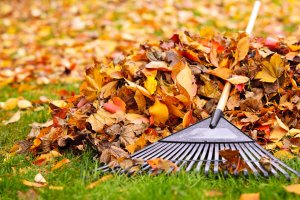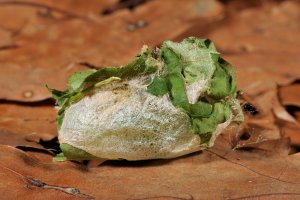Wild Wednesday: Leave your Leaves this Fall
October 12, 2022 Erin Parker, Interpretive Services Supervisor
Signs of autumn are everywhere in the Metroparks; from the last of the migrating songbirds to the first hints of color showing up in the trees. On warm afternoons, the late-blooming flowers are covered in pollinators making their preparations before the first hard frosts and snakes may be observed basking on warm rocks and paved trails.
Much like the busy bees on the flowers, gardeners everywhere are starting to consider their fall chores to prepare their plants and garden beds for winter. One chore that gardeners can skip is removing fallen leaves and yard waste from their property!

Autumn leaves and water quality
Leaves and other organic debris can pose a problem for our waterways, so keeping them out of stormwater ditches, culverts, and roads can help reduce water quality problems. When leaves and other organic debris decompose, the decomposing organisms can utilize much of the dissolved oxygen in the water which can cause problem for fish and other aquatic life. The sudden increase in nutrients, such as phosphorus and nitrogen, released as the leaves break down, can also feed algae and further contribute to loss of oxygen in the water. While nutrients seem like a healthy part of an aquatic ecosystem, the volume of leaves entering our waterways from culverts, streets, and other surfaces can be much greater that our freshwater systems can handle.
Leaves in a landfill
Leaves and yard waste that make it to the landfill may help our lakes and streams, but aren’t a great solution either! In a landfill, these organic materials get buried and the only decomposers that can survive in these conditions are anaerobic (without oxygen). One of the byproducts of anaerobic decomposition is heat-trapping gases such as methane, a major contributor to climate change.
Backyard ecosystem benefits
Leaving our leaves on the ground, whether raked up into garden beds or mulched into the lawn, reduces the flood of organic matter into our local lakes and streams. Many organisms rely on leaves over the winter as shelter from the cold and snow, including a diversity of moths, butterflies, and beetles, including the beloved fireflies. Leaves, left to slowly break down over the winter months, also help to feed and shelter small predators such as toads and salamanders. The slow decomposition of leaf matter feeds the soil with those same nutrients that overwhelm our aquatic ecosystems, reducing the need for fertilizers and other chemical additives. A barrier of leaves can also suppress weed growth, saving the gardener time and energy!

Put down the power tools
So what is a homeowner or gardener to do? Luckily, there are many solutions to managing autumn’s bounty.
- Leaves can be raked into garden beds to function as mulch and slow-release fertilizer
- Raised beds can be filled with leaves, sticks, and other organic debris that will break down slowly over time and feed future garden crops
- Leaves on the lawn can be mulched with a mower and the small pieces will feed the soil without smothering the grass
- A thick layer of wet leaves and cardboard or newspaper can be utilized to smother a patch of lawn over the winter to create a new garden bed in the spring
- Create a compost bin or area. Leaves and yard scraps can break down slowly, but the oxygenated conditions (unlike a landfill) do not produce the methane and other climate-change contributing gases. Compost can then be added to garden beds in the spring and summer
- Use leaves as a barrier for tender plants to help buffer them from wind, ice, and cold temperatures
